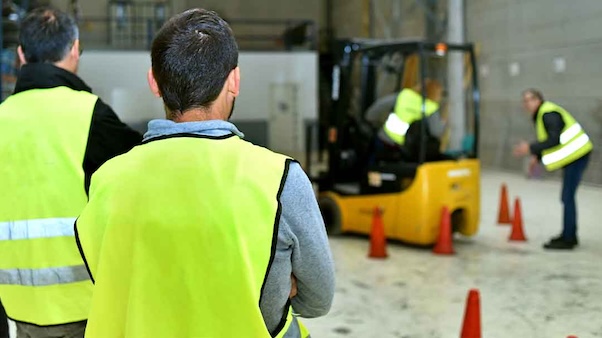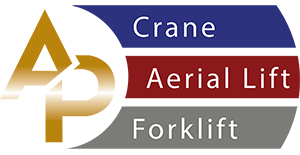
Learning to operate a forklift is a crucial skill that demands precision, knowledge, and adherence to safety protocols. Here are a few simple strategies to help guide you, even though these recommendations are simple and quite basic, they're a good starting place to encourage workplace health and security guidelines
1. Attaining Operator Qualification
The operation of forklifts is a specialized task that requires competent individuals at the helm. Only those who have undergone proper training and possess a valid license should be entrusted with the responsibility of operating forklifts. This ensures a skilled workforce and minimizes the risk of accidents.
With our forklift train-the-trainer training, you can enable your personnel to independently give effective and standardized training to forklift operators, assuring continued competence and safety.
2. Ensuring Appropriate Safety Attire
The attire worn by operators plays a pivotal role in ensuring their safety and the smooth execution of tasks. Operators must be equipped with the appropriate safety work-wear, which typically includes a sturdy hard hat, protective safety shoes, and high-visibility jackets. It's imperative that the attire fits well, as loose clothing poses the risk of entanglement with machinery.
Moreover, it's essential never to manipulate the controls while hands are soiled, as this may lead to slippage and potential mishaps. Maintaining a firm grip is vital to prevent accidents and ensure seamless forklift operation.
3. Thorough Pre-Use Equipment Examination
Prior to setting any forklift into motion, operators must meticulously inspect their equipment. A comprehensive assessment should cover a range of vital components, including brakes, steering mechanisms, controls, warning devices, mast integrity, and tire condition. Any detected flaws or malfunctions should be promptly reported to management, and under no circumstances should a forklift with outstanding issues be operated until it has been appropriately repaired.
Furthermore, a key consideration when lifting loads is the destination point. Picking up a load is not only about its current location; operators must assess whether the final placement is conducive to safe stacking and storage.
4. Ensuring Proper Forklift Setup
Safety begins with the operator's position within the forklift. To establish a secure starting point, operators must adhere to a series of essential steps. The utilization of accessible steps and handholds ensures a stable entry into the cabin. Before initiating the forklift, it is imperative to verify that all controls are functional and properly engaged. Equally vital is the adjustment of the seat position and mirrors to match the operator's specific requirements.
Only after these preparations are complete should the operator consider setting the forklift in motion. Prior to doing so, it is essential to be securely seated with the safety belt fastened. Additionally, the operator's entire body must remain within the confines of the operator's cabin or the designated forklift boundaries. This precautionary measure guarantees a safe and controlled operating environment.
5. Environment Awareness and Adherence
When working with a forklift, keen attention to the surrounding environment is paramount. Operators must listen attentively and diligently follow all workplace rules and guidelines. To ensure safe navigation, the forklift should exclusively traverse designated pathways and roadways, adhering to proper signage and warnings, particularly those indicating maximum floor loadings and clearance heights.
It is crucial to remain conscious of the dimensions of the load, mast, and overhead protection when entering or exiting buildings. Operating near the edge of loading docks or slopes demands extra caution, as the forklift's stability can be compromised. Maintaining a secure distance from the edge mitigates the risk of unintentional falls.
Furthermore, exercising caution when using bridge plates is essential. These plates should only be utilized if they can adequately support the combined weight of the forklift and its load.
6. Operating with Prudent Speed and Control
Tempering speed with prudence is a hallmark of responsible forklift operation. Staying within speed limits and maneuvering with deliberate care reduces the risk of tipping. When navigating corners or engaging in any operational changes, gradual and steady movements are key to maintaining control and stability.
7. Mitigating Potential Hazards
Mitigating risks is a fundamental tenet of forklift operation. Operators should avoid uneven surfaces, slippery conditions, and any obstacles that could compromise control. Loose objects on the ground pose a particular threat and should be circumvented to ensure safe passage.
Enhancing pedestrian safety is paramount. When approaching corners, doorways, or entrances, operators should employ the horn to alert pedestrians and other forklift operators, averting potential collisions. Additionally, maintaining a safe distance from other vehicles, particularly those exhibiting irregular movements, reduces the chances of unexpected interactions.
8. Ensuring Load Safety and Stability
Safeguarding loads is a paramount consideration in forklift operation. Meticulous attention must be paid to the condition and stability of the loads before they are in motion. To ensure stability and prevent damage, thorough checks are imperative.
Maintaining proper load distribution is key. When transporting loads, tipping the load backward and positioning the forks low contributes to truck stability. Careful assessment for any overhead obstacles is vital before lifting or stacking loads. Loads that are not secure or stable should never be lifted or moved.
Proper stacking and positioning of loads on pallets or skids is essential. Utilizing securing measures, such as straps or bindings, adds an extra layer of safety when required.
9. Optimizing Visibility for Safe Operation
Clear visibility is the cornerstone of safe forklift operation. While driving in reverse can enhance visibility, this practice should be avoided when ascending ramps. Ensuring a clear line of sight to the racking where the load will be placed is of utmost importance.
In instances of poor visibility, it is imperative not to proceed. In such cases, enlisting the assistance of a lookout helper can be invaluable, ensuring safe navigation in challenging conditions.
10. Upholding the Purpose of Forklifts
Forklifts are dedicated to the task of load transportation and must be used exclusively for this purpose. Under no circumstances should operators allow others to ride on the equipment unless an additional seat is securely affixed to the forklift. If there is a need to elevate an individual, a properly attached work platform must be utilized, and the appropriate operating instructions diligently followed.
1 1. Ensuring Mast Safety
The mast of a forklift demands utmost respect and caution. Under no circumstances should anyone be allowed to stand or walk beneath the load or the machinery. The potential for a catastrophic collapse is all too real, posing a severe risk to life and limb.
Furthermore, hands and feet must be kept at a safe distance from the cross members of the mast. A momentary lapse can lead to serious injury if the mast were to unexpectedly descend while a hand is in close proximity.
12. Navigating Ramps with Precision
Ramp navigation requires a nuanced approach. Ascend ramps in a forward motion and descend in reverse, particularly when carrying loads. Loading and unloading or making any sudden turns while on a ramp is strongly discouraged, as it introduces unnecessary risk.
13. Preventing Overloading Hazards
Exercising caution with regard to load capacity is non-negotiable. Never resort to using the tip of the forks as a lever to lift a heavy load, nor should a load be pushed using the fork's tip. It is imperative to understand the load-bearing potential of the forklift and any attachments being employed, always staying well within the stipulated limits.
Overloading can have dire consequences, potentially causing the rear tires to lose contact with the ground and tipping the forklift.
14. Ensuring Even Load Distribution
Maintaining an even load distribution is critical for both safety and efficiency. Never attempt to lift or move a load unless both forks are fully and securely beneath it. Lifting a load with a single fork is strictly prohibited, as it can compromise stability.
For optimal results, employ skids and pallets that are designed to withstand the weight of the load. Additionally, steer clear of using damaged, deformed, or decayed pallets for holding loads, as this introduces unnecessary risks.

15. Safeguarded Refueling
Refueling a forklift is a task that demands meticulous care and adherence to specific guidelines. Refueling should solely occur at designated refueling stations to prevent potential hazards.
Prior to refueling, the forklift must be completely turned off. For forklifts powered by internal combustion engines (IC), it is crucial to avoid any open flames or sparks during refueling. Moreover, the refueling process should take place in a well-ventilated area, ensuring a safe and fume-free environment.
16. Ensuring a Proper Conclusion
The conclusion of a shift requires a series of deliberate actions to guarantee the safety of the equipment and all personnel involved. Once usage is complete, it is imperative to park the forklift in an approved or designated area. Lower the forks completely to the ground and engage the parking brake to secure the equipment in place.
Turning the forklift "off" and removing the key are pivotal steps in proper shutdown. It is crucial never to leave a forklift running while unattended, as this poses unnecessary risks.
Read more:
If you are a forklift operator already and are in need of a forklift license renewal class or possible recertification contact us today at (888) 501-1355 toll free
